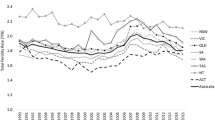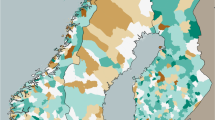Abstract
Standard regression model parameters are assumed to apply globally over the entire territory where measured data have been taken, under the assumption of spatial stationarity in the relationship between the variables under study. In most cases this assumption is invalid. Instead, geographically weighted regression (GWR) explicitly deals with the spatial non-stationarity of empirical relationships. Considering a georeferenced dataset on provincial total fertility rate (TFR) in Italy, GWR technique shows a significant improvement in model performance over ordinary least squares (OLS). We also discuss about the test for spatial non-stationarity.
Access this chapter
Tax calculation will be finalised at checkout
Purchases are for personal use only
Similar content being viewed by others
Notes
- 1.
For GWR is defined as: \(AI{C}_{c} = 2n\;ln(\hat{\sigma } + n\;ln(2\pi ) + n\left \{ \frac{n+tr(S)} {n-2tr(S)}\right \}\), where n is the sample size, \(\hat{\sigma }\) is the estimated standard deviation of he error term and tr(S) is the trace of the hat matrix (Fotheringham et al., 2002).
References
Bowman, A. W. (1984). An alternative method of cross valifdation for the smoothing of density estimates. Biometrika, 71, 353–360.
Brunsdon, C., Fotheringham, A. S., & Charlton, W. (1999). Some notes on parametric signficance tests for geographically weighted regression. Journal of Regional Science, 39(3), 497–524.
Cleveland, W. S. (1979). Robust locally weighted regression and smoothing scatterplots. Journal of the American Statistical Association, 74, 829–836.
Foody, G. M. (2003). Geographical weighting as a further refinement to regression modeling: An example focused on the NDVI – rainfall relationship. Remote sensing of Environment, 88, 283–293.
Fotheringham, A. S., Charlton, M., & Brundson, C. (2002). Geographically weighted regression: The analysis of spatially varying relationships. Chichester: Wiley.
Greig, D. M. (1984). Optimisation. London: Longman.
Hastie, T., & Tibshirani, R. (1993). Varying-coefficient models. Journal of the Royal Statistical Society, Series B, 55, 757–796.
Hurvich, C. M., Simonoff, J. S., & Tsai, C.-.L. (1998). Smoothing parameter selection in nonparametric regression using an improved Akaike information criterion. Journal of the Royal Statistical Society, Series B, 60, 271–293.
Leung, Y., Mei, C. -L., & Zhang, W. -X. (2000). Statistical tests for spatial non-stationarity based on the geographically weighted regression model. Environment and Planning A, 32, 9–32.
Loader, C. (1999). Local regression and likelihood. New York: Springer.
Mucciardi, M., & Bertuccelli, P. (2011). A GWR model for local analysis of demographic relationships. China-USA Business Review, 10(3), 236–244.
Wang, Q., Ni, J., & Tehnhunen, J. (2005). Application of a geographically-weighted regression analysis to estimate net primary production of Chinese forest ecosystems. Global Ecology and Biogeography, 14, 379–393.
Acknowledgements
The authors would like to thank the anonymous reviewers who provided detailed feedback on the earlier version of this article.
Author information
Authors and Affiliations
Corresponding author
Editor information
Editors and Affiliations
Rights and permissions
Copyright information
© 2013 Springer-Verlag Berlin Heidelberg
About this paper
Cite this paper
Mucciardi, M., Bertuccelli, P. (2013). Modelling Spatial Variations of Fertility Rate in Italy. In: Giusti, A., Ritter, G., Vichi, M. (eds) Classification and Data Mining. Studies in Classification, Data Analysis, and Knowledge Organization. Springer, Berlin, Heidelberg. https://doi.org/10.1007/978-3-642-28894-4_30
Download citation
DOI: https://doi.org/10.1007/978-3-642-28894-4_30
Published:
Publisher Name: Springer, Berlin, Heidelberg
Print ISBN: 978-3-642-28893-7
Online ISBN: 978-3-642-28894-4
eBook Packages: Mathematics and StatisticsMathematics and Statistics (R0)




